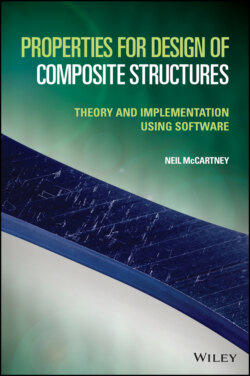Читать книгу Properties for Design of Composite Structures - Neil McCartney - Страница 50
3.3 Bulk Modulus and Thermal Expansion Coefficient 3.3.1 Spherical Particle Embedded in Infinite Matrix Subject to Pressure and Thermal Loading
ОглавлениеConsider an isolated particle of radius a perfectly bonded to an infinite surrounding matrix, subject to a pressure p applied at infinity and a uniform temperature change ΔT from the stress-free temperature at which the stresses and strains in particle and matrix are zero. The displacement field in the particle and surrounding matrix is purely radial so that displacement components (ur,uθ,uϕ), referred to a set of spherical polar coordinates (r, θ, ϕ) with origin at the particle centre, are of the form
(3.13)
The corresponding strain field obtained from (2.142) is then given by
(3.14)
The stress field follows from stress-strain relations expressed in the form (see (2.160) for the Cartesian equivalent)
(3.15)
where λ and μ are Lamé’s constants and where α is now the linear coefficient of thermal expansion. On using the equilibrium equations (2.130)–(2.133), it can be shown that, within the spherical particle of radius a, the resulting bounded displacement and stress fields are given by
(3.16)
(3.17)
where kp= λp+23μp and μp are the bulk and shear moduli, respectively, for the particulate reinforcement, and where αp is the corresponding thermal expansion coefficient. Clearly the strain and stress distributions within the particle are both uniform. For the matrix region it can be shown that
(3.18)
(3.19)
where km= λm+23μm and μm are the bulk and shear moduli, respectively, for the matrix, and where αm is the corresponding thermal expansion coefficient. The stress component σrr is automatically continuous across r = a having the value −p0. As the displacement component ur must also be continuous across this interface, the value of p0 must satisfy the relation
(3.20)
